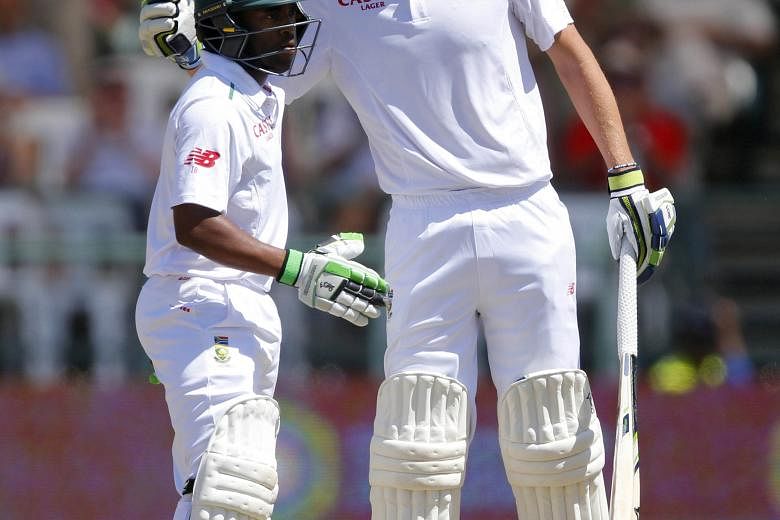With a bat in their hands, Hashim Amla and Temba Bavuma did more in two days this week than all of the politicians have attempted to do over two decades in post-apartheid South Africa.
By standing at the crease for 11 hours and 47 minutes to hit a double century, Amla set a captain's example of defiance against England's presumption of superiority in Test cricket.
By following his leader to complete the first Test century ever by a black South African, Bavuma charmed the world into believing that it is neither the colour of a man's skin, nor the size of his physical stature that matters.
And by the end of the Test match which was drawn after rain and bad light saved England after a second innings collapse, South Africa (and world sport) was all the better.

Slightly better, anyway.
The country still has its legacy of racial divide. Shortly before Amla led the fightback to England's mammoth 629 first-innings total, a "lady", Penny Sparrow, obviously a white lady, was trending on Twitter after calling for blacks (who she referred to as monkeys) to be barred from littering beaches.
A Standard Bank economist, obviously a white economist, Chris Hart, was later suspended after tweeting on Jan 3: "More than 25 years after apartheid ended, the victims are increasing along with a sense of entitlement and hatred towards minorities."
The apologies from Mrs Sparrow and Mr Hart came as too little too late to stop the public outcry.
An editorial in Tuesday's Cape Times talked about the soothing balm of forgiveness running out while intolerance and downright bigotry were being stoked.
"What Amla and Bavuma achieved," the paper suggested, "was therefore more than a drop in the stormy ocean of South Africa's race relations in an economic crisis."
What they did was, first and foremost, play to the very best of their ability.
It is the beauty of sport that can, or should, turn racial stereotyping on its stupid head.
Where have the racists been these past 80 years if they still believe colour or creed makes any difference to a man, or woman's, athletic performance?
Think Jesse Owens and the 1936 Olympic Games in Berlin.
Think Pele at the 1958, 1962 and 1970 World Cups.
Think Muhammad Ali, who lived up to his rhetoric of being the best boxer of all time.
And, yes, think of Amla and Bavuma today.
Both are trying to justify themselves as sportsmen, but both have to listen to insinuation that they were promoted to the Proteas, the South African national team.
Amla's painstaking 200 runs was by no means his top score. He was undefeated on 311 against England at the Oval in London three years ago.
But on Tuesday, he stepped down as captain of South Africa. He said it was to concentrate on his batting. Others say it is because he is uncomfortable in the role of captaincy, that he is an introverted personality, better suited to playing his singular role.
Maybe, but another thing the 32-year-old was uncomfortable with was being cast as a "token" captain. A captain because South African cricket wanted to make a point about race by asking a man of Indian descent, and a practising Muslim at that, to lead.
Regardless, Amla came through one of the country's most respected cricketing schools, Durban High School where Lance Klusener and Barry Richards were taught before him. And he came through a middle-class family.
Bavuma's background is more of a story, given South Africa's history.
He was born at Langa township outside of Cape Town.
Township is a euphemism for the type of overcrowded, underprivileged estates the like of which you never see in Singapore. Many of the houses are shacks with corrugated iron roofs, no running water or electricity.
Langa, which actually was founded by a white man, was as noted as Soweto for opposing apartheid. I have to say that I have visited both, and found fun and laughter (and spontaneous acceptance there in spite of my colour).
Young Temba's first bat was a makeshift piece of discarded wood. But his family moved to Johannesburg when his father, a sports journalist, took a job there. Temba was then 17, and was granted a cricket scholarship to St David's Marist School, founded by Roman Catholic priests.
Again, when South Africa chose him for the Test side, the opinion spread that it was on grounds of ethnicity rather than merit.
All non-whites who gain a place on South African cricket or rugby fields face this aspersion. It comes with the territory of government imposing quota systems to force sports to accept a number of black, coloured or Indian players to reverse the segregation that disfigured life during minority rule.
Bavuma is aware of what it means to be the first indigenous African to score a Test hundred. It came in his seventh Test, before which he had said: "I have come to realise that there are a lot of people out there that I represent. I'm not just playing for myself."
He is aged 24, and not a kid, though he might be mistaken for one. "Tiny Temba" one British newspaper named him this week in reference to his shortness. Bavuma stands just over 1.60m.
He isn't the tallest, nor is he the smallest in Test cricket. Cornelius Kruger van Wyk, measuring 1.45m, was born in South Africa but kept wicket for New Zealand in nine Tests in 2012.
A fellow called Walter (Tich) Carnford stood at 1.52m when he played for England in 1930. The legendary "Little Master" of India, Sachin Tendulkar, was a mighty 1.67m, but his compatriot Gundappa Viswanath touched a similar height to Bavuma.
So size isn't an issue in international cricket. Size plus colour prejudice together, however, were quite formidable to overcome in a South African township. Bavuma is going to inspire more youngsters than government quotas ever could.
As to Mrs Sparrow? Somewhere in that backward brain of hers there must be a glimmer of acknowledgment that the boy can bat with the best.


